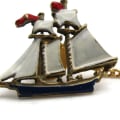Emperor Augustus, who reigned in ancient Rome from 31 BC. C. In 14 AD, he set the price of gold between 40 and 42 coins per pound. In other words, a pound of gold could produce 40 to 42 coins.
Nowadays, many investors are turning to gold IRA home storage as a way to protect their investments. In most ancient cultures, gold was popular in jewelry and art because of its value, aesthetic qualities, ductility and malleability. Electrum (the natural alloy of gold and silver) was used in jewelry by Egyptians from 5000 BC. Both men and women wore gold jewelry in the Sumerian civilization around 3000 BC. C., and gold chains were produced for the first time in the city of Ur in 2500 BC.
To the Minoan civilization of Crete, at the beginning of the second millennium a. C., is credited with producing the first jewelry with a cable-type chain, and the Minoans manufactured a wide range of jewelry items using a wide range of techniques. Gold jewelry took the form of necklaces, bracelets, earrings, rings, headbands, pendants, pins and brooches. The techniques and forms included filigree (a technique known to the Egyptians since 2500 BC).
C.) in which gold was dragged on wire and twisted in different designs), fine whipped shapes, granulating (decorating the surface with small soldered gold beads), stamping, profiling, inlay, molding and engraving. In South America, gold was processed in a similar way by the Chavín civilization of Peru around 1200 BC. and the Nazca society perfected gold smelting starting in 500 BC. The Romans used gold as a setting for precious and semiprecious gems, a trend that continued in the Byzantine era with the use of pearls, gems and enamels.
The “value” of gold was accepted all over the world. Today, as in ancient times, the intrinsic appeal of gold itself has that universal appeal to humans. But how did gold become a commodity, a unit of measurable value?. Second, there is a difference between real and nominal inflation, and we have experienced both in the last 4,000 years.
The increase in per capita monetary stocks of gold and silver translates into a corresponding increase in prices and wages in terms of gold and silver, representing real inflation. Nominal inflation occurs when the money supply increases in the absence of an increase in gold and silver. This can happen by printing paper money without backing, as we do today, or reducing gold and silver from coins, as was the case in ancient Rome. Either case translates into an increase in prices and wages in terms of the official monetary unit (paper or currency) as that unit deteriorates against gold and silver.
Therefore, the lessons of Roman economic history have some value for the modern world, not least because the Romans degraded their money over a very long period of time. Estimated silver inventory per capita 26% of world gold Cumulative gold production (billions of ounces) World gold inventory per person (ounces) Cumulative. Silver production (billions of ounces) Global inventory of silver per person (ounces) Even so, the table above provides an overview of the situation. During the third millennium BC, gold and silver were used mainly as decoration, ornamentation and as a repository of wealth.
The Babylonian invention of the shipyard scale allowed for an accurate measurement of weight, facilitating a monetary revolution, since gold and silver could now serve as units of account. For the sake of brevity, I deleted a section on early Iron Age. For anyone interested in examining biblical prices, I'll mention that the Hebrew shekel was equivalent to 14.1 grams of silver. This larger size, which is still 20 gerahs per shekel 3, is probably due to the greater inventory of silver per capita near the end of the second millennium BC.
Athenian and Persian monetary systems An attic talent %3D 60 mines %3D 6,000 drachmas. By the attic standard, 1 talent, 3D, 25,800 grams or 829 troy ounces of silver. State revenues of Athens and Persia Since the beginning of this system, Rome began to play with it, continuously reducing the weight of its currencies. A monetary reform in 225 a.
introduced the gold state with a value of 48 aces, three new silver coins to replace the didrachma and smaller bronze coins than before. The Ace was reduced to 140 grams. After a continuous downturn, another monetary reform in 211 a. introduced the denarius of 4 grams of silver, the ancestor of the modern penny, with a value of 10 aces.
The Ace, which was still the Roman counting unit, was reduced to 48 grams of bronze. The following table shows the basic monetary system c, 100 a. Some facts from the 1st century BC. come from inscriptions found in Rome (of the innkeeper, the Bill).
The craftsmen earned 12 bases a day. This was equivalent to 4.2 grams of silver, twice the daily wage in Babylon. Legionnaires before Caesar earned 5 aces a day. After Caesar they won 10 aces a day.
A meal of stew and wine at an inn costs 3 aces: 2 for stew and 1 for wine. Hay for a mule at the inn costs 2 aces, while a prostitute at the same inn costs 2 to 8 aces. Among the Jews, the Greeks and the Romans, Western civilization has three fathers, and it is very regrettable that we have obtained our concept of money from the latter. If the fiat money experiment of the 20th century fails in our lives, it will be fascinating to see what the prices and wages of gold and silver turn into, but it will most likely be a very unpleasant experience, not something you can hope for.
From the ancient Egyptians to the modern United States,. Treasure, there are few metals that have played such an influential role in human history as gold. Why is gold so important? What is the inherent value of gold? Will gold continue to be valuable in the future? Today I'm going to answer those questions and share with you the history of gold. Most archaeological evidence shows that humans who came into contact with gold were impressed by the metal.
Since gold is found all over the world, it has been mentioned numerous times in ancient historical texts. The Egyptians also produced gold maps, some of which survive to this day. These gold maps described where to find gold mines and several gold deposits in the Egyptian kingdom. As much as the Egyptians loved gold, they never used it as a bartering tool.
Instead, most Egyptians used agricultural products such as barley as a form of de facto money. The first known civilization to use gold as currency was the Kingdom of Lydia, an ancient civilization centered in western Turkey. Later in history, the ancient Greeks saw gold as a symbol of social status and as a form of glory among immortal gods and demigods. Mortal humans could use gold as a sign of wealth, and gold was also a form of currency.
Contrary to what you might think, the Olympic tradition of handing out gold medals to winners did not begin until the modern Olympic Games and has little to do with Greek tradition. In 1792, the United States Congress made a decision that would change the modern history of gold. Congress passed the Currency and Coins Act. This law established a fixed price of gold in terms of the U.S.
UU. Gold and silver coins became legal tender in the United States, as did the Spanish real (a silver coin of the Spanish Empire). That proportion would change after the Civil War. During the Civil War, the United States,.
He couldn't pay all his debts with gold or silver. In 1862, paper money was declared legal tender, marking the first time that fiat currency (not convertible on demand at a fixed rate) was used as official currency in the United States. The United States would never use silver dollars again. At the end of the 19th century, the topic continued to be an important political issue.
In 1900, the gold dollar was declared to be the standard unit of account in the United States and banknotes were issued to represent the country's gold reserves. Throughout the 19th century, several gold fevers occurred. Since a single gold nugget could make someone a millionaire, prospectors rushed to distant corners of the planet in search of wealth. The two world wars wreaked havoc on the gold standard and on global financial markets.
Of course, it didn't help that the Great Depression occurred between those two wars. After decades of war and conflict, world leaders united under the Bretton Woods Agreements. This system created a gold exchange pattern in which the price of gold was fixed in the U.S. This was a radical experiment that had never been done before and that made the United States very powerful in world markets.
The dollar was chosen for the Bretton Woods system because the United States was easily the strongest economy in the world after World War II. . The day the price of gold was linked to the United States. The dollar is one of the most important points in the United States.
Between 1971 and 1976, several attempts were made to save the gold standard. However, the price of gold continued to rise beyond what any currency could sustain. Of course, that doesn't mean that countries have sold all their gold or that their currencies aren't based on anything. Most countries in the world maintain large gold reserves to defend their currency against possible future emergencies.
As with everything called “classified” in the United States, there are many conspiracy theorists who argue that Fort Knox is actually empty and that the gold is stored somewhere secret or doesn't exist at all. You'll have to figure that out on your own. When looking at gold investment charts, it's important to recognize inflation. Some charts show the price of gold practically as a straight line from the lower left corner of the chart to the upper right corner.
By carefully weighing all this information and current trends, you can build an accurate view of the current and future value of gold. Like any commodity, it is impossible to accurately predict the price of gold. Many have tried and many have failed. Every day, thousands of investors around the world study all the metrics involved in the price of gold.
Some of these experts will take all of this information and accurately predict the future price of gold, while other experts will see the same information and guess wrong. If you want to get rich with gold, then you need to find experts you trust. Find an expert who has accurately predicted several peaks in the value of gold throughout history. Find someone who will take all the information available and use it to make an informed decision.
Or try researching the information yourself and see if you can guess correctly. Ultimately, the price of gold has grown fairly steadily over the past few decades, and many experts predict that it will continue its gradual rise over the next few years. This site uses Akismet to reduce spam. Find out how your comment data is processed.
Gold tokens are stable currencies whose value is backed by real gold ingots stored in an auditable and secure vault. Concern for the authenticity of gold led the Egyptians to devise a method for determining the purity of gold around 1500 BC. (or before). As a decorative coating, gold plating and gold leaf (gold beaten in extremely thin sheets) have been used to decorate shrines, temples, tombs, sarcophagi, statues, ornamental weapons and armor, ceramics, glassware and jewelry since Egyptian times.
With the end of the gold standard and the availability of ingots to the general public in the United States, the history of the price of gold was about to change. As an investor, it's important to note that gold is still traded in US dollars, which means that the price of gold in Canada can also be affected by the exchange rate. The salt mixed with silver and formed a vapor of silver chloride that left pure gold, which could be used to create a standardized minting with a guaranteed gold content. Gold prospecting was a global effort that dates back thousands of years, even before the first money in the form of gold coins appeared, around 700 BC.
Gold is such a precious material that for centuries several attempts were made to produce it through alchemy, that is, the chemical transformation of base metals into gold using the philosopher's stone (lapis philosophhorum). The Mint was legally required to buy and sell gold and silver at a rate of 15 parts of silver to 1 part of gold. Even the purest natural gold can contain 5% silver, but Lydians could refine their gold using salt and furnace temperatures of between 600 and 800°C. The first pure gold coins with printed images are attributed to King Croesus of Lydia, between 561 and 546 in.
C., and a contemporary gold refinery has been excavated in the capital, Sardis. Gold was associated with water (that's logical, since most of it was found in streams), and gold was supposed to be a particularly dense combination of water and sunlight. The first civilizations equated gold with the gods and rulers, and gold was sought in its name and dedicated it to its glorification. .



